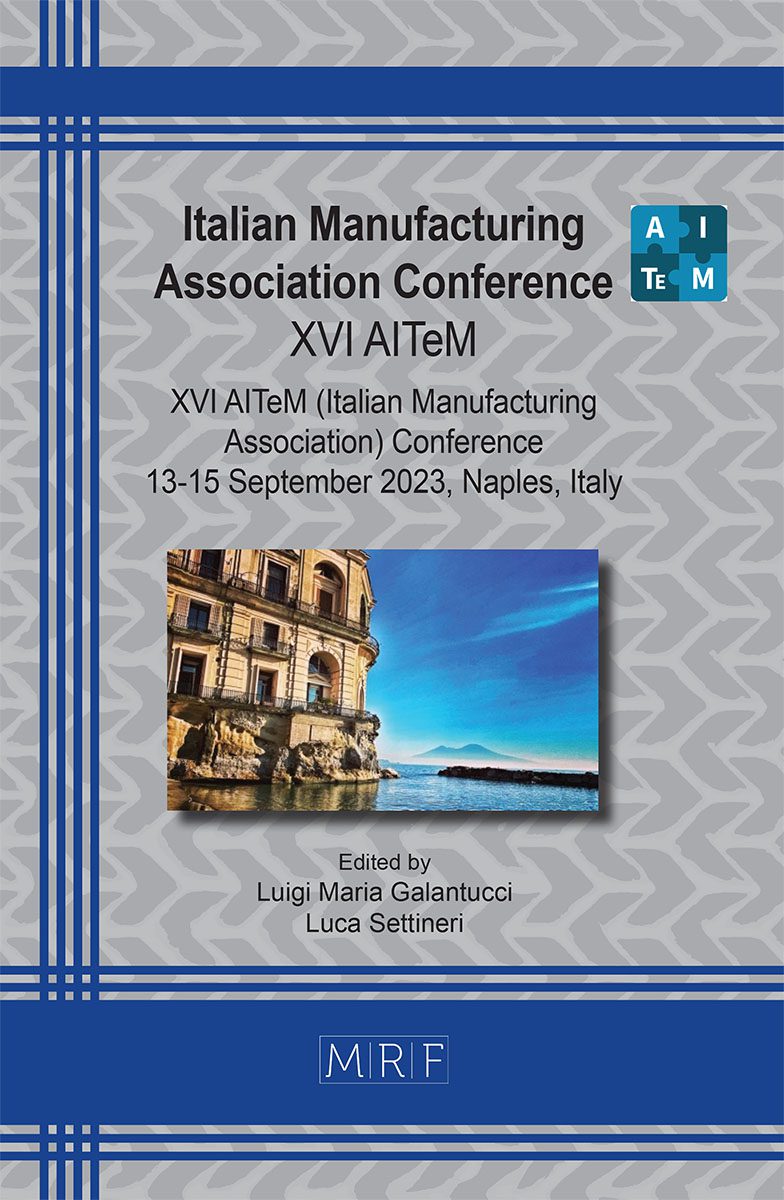Feasibility study and stress analysis of friction stir extruded rods and pipes: a simulative model
Sara Bocchi, Cristian Cappellini, Gianluca D’Urso, Claudio Giardini
download PDFAbstract. The traditional aluminium recycling process consumes a lot of energy and adversely affects the metallurgical quality of the secondary alloys produced. With the increasing need for resolving this problem, Friction Stir Extrusion (FSE) has been patented. FSE is a new solid-state recycling process through which parts can be extruded directly from waste. In this research, the analysis was focused on different process parameters, process set ups and geometries of the extruded parts. The traditional setup, where the tool rotates and advances while the chamber remains stationary, was considered, and a new one was introduced. In this configuration, the tool has only an advance feed, while rotation is performed through the chamber. Moreover, for each combination of process parameters the bonding phenomena occurrence, considering both the thermal and the stress conditions generated by the parameters, was analysed. For this purpose, the Piwnik and Plata criterion was chosen.
Keywords
Sustainable Processes, Aluminium Alloys, Friction Stir Extrusion
Published online 9/5/2023, 8 pages
Copyright © 2023 by the author(s)
Published under license by Materials Research Forum LLC., Millersville PA, USA
Citation: Sara Bocchi, Cristian Cappellini, Gianluca D’Urso, Claudio Giardini, Feasibility study and stress analysis of friction stir extruded rods and pipes: a simulative model, Materials Research Proceedings, Vol. 35, pp 420-427, 2023
DOI: https://doi.org/10.21741/9781644902714-50
The article was published as article 50 of the book Italian Manufacturing Association Conference
![]() Content from this work may be used under the terms of the Creative Commons Attribution 3.0 license. Any further distribution of this work must maintain attribution to the author(s) and the title of the work, journal citation and DOI.
Content from this work may be used under the terms of the Creative Commons Attribution 3.0 license. Any further distribution of this work must maintain attribution to the author(s) and the title of the work, journal citation and DOI.
References
[1] D. Baffari, G. Buffa, D. Campanella, L. Fratini, A.P. Reynolds, Process mechanics in Friction Stir Extrusion of magnesium alloys chips through experiments and numerical simulation, J. Manuf. Process. 29 (2017) 41–49.
[2] V.C. Shunmugasamy, E. Khalid, B. Mansoor, Friction stir extrusion of ultra-thin wall biodegradable magnesium alloy tubes — Microstructure and corrosion response, Mater. Today Commun. 26 (2021) 102129. https://doi.org/10.1016/j.mtcomm.2021.102129
[3] W.T. Evans, B.T. Gibson, J.T. Reynolds, A.M. Strauss, G.E. Cook, Friction Stir Extrusion: A new process for joining dissimilar materials, Manuf. Lett. 5 (2015) 25–28. https://doi.org/10.1016/j.mfglet.2015.07.001
[4] R.M. Izatt, Metal Sustainability: Global Challenges, Consequences, and Prospects, Wiley, 2016. https://doi.org/10.1002/9781119009115
[5] R.A. Behnagh, N. Shen, M.A. Ansari, M. Narvan, M. Kazem, B. Givi, H. Ding, Experimental analysis and microstructure modeling of friction stir extrusion of magnesium chips, J. Manuf. Sci. Eng. Trans. ASME. 138 (2016). https://doi.org/10.1115/1.4031281
[6] H. Zhang, X. Li, W. Tang, X. Deng, A.P. Reynolds, M.A. Sutton, Heat transfer modeling of the friction extrusion process, J. Mater. Process. Technol. 221 (2015) 21–30. https://doi.org/10.1016/j.jmatprotec.2015.01.032
[7] D. Baffari, G. Buffa, L. Fratini, A numerical model for Wire integrity prediction in Friction Stir Extrusion of magnesium alloys, J. Mater. Process. Technol. 247 (2017) 1–10. https://doi.org/10.1016/j.jmatprotec.2017.04.007
[8] M. Plata, J. Piwnik, Theoretical and experimental analysis of seam weld formation in hot extrusion of aluminum alloys, in: 7th Int. Alum. Extrus. Technol., 2000: pp. 205–211.
[9] S. Bocchi, G. D’urso, C. Giardini, G. Maccarini, A Simulative Method for Studying the Bonding Condition of Friction Stir Extrusion, Key Eng. Mater. 926 KEM (2022) 2333–2341. https://doi.org/10.4028/P-FT5355
[10] E. Ceretti, L. Fratini, F. Gagliardi, C. Giardini, A new approach to study material bonding in extrusion porthole dies, CIRP Ann. – Manuf. Technol. 58 (2009) 259–262. https://doi.org/10.1016/j.cirp.2009.03.010































